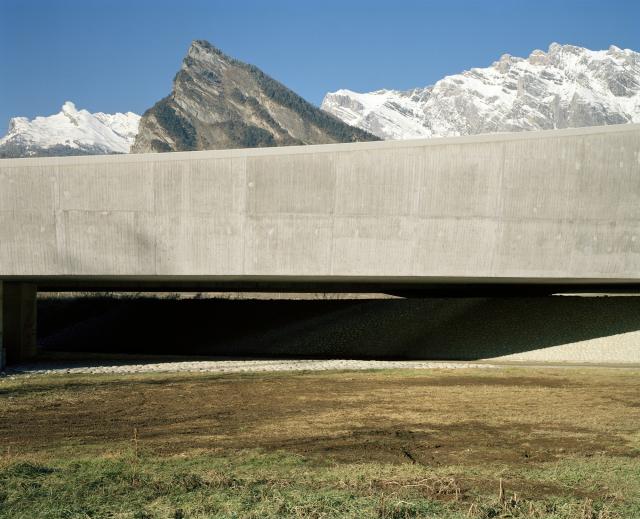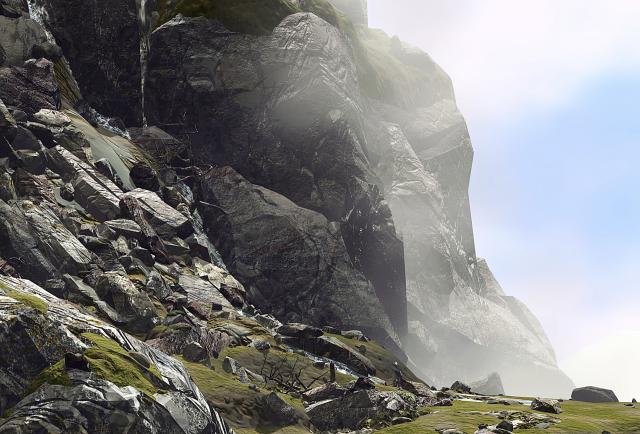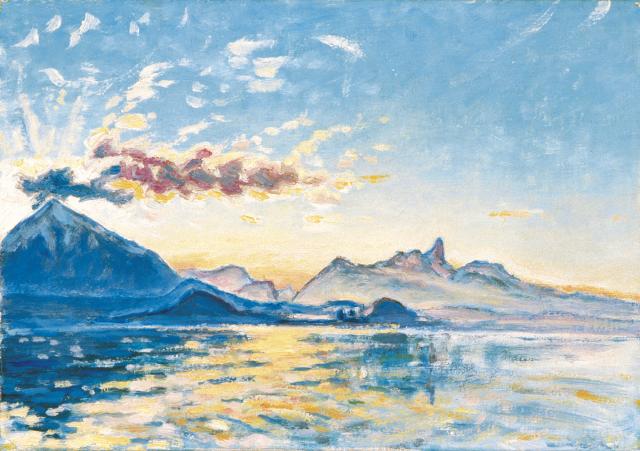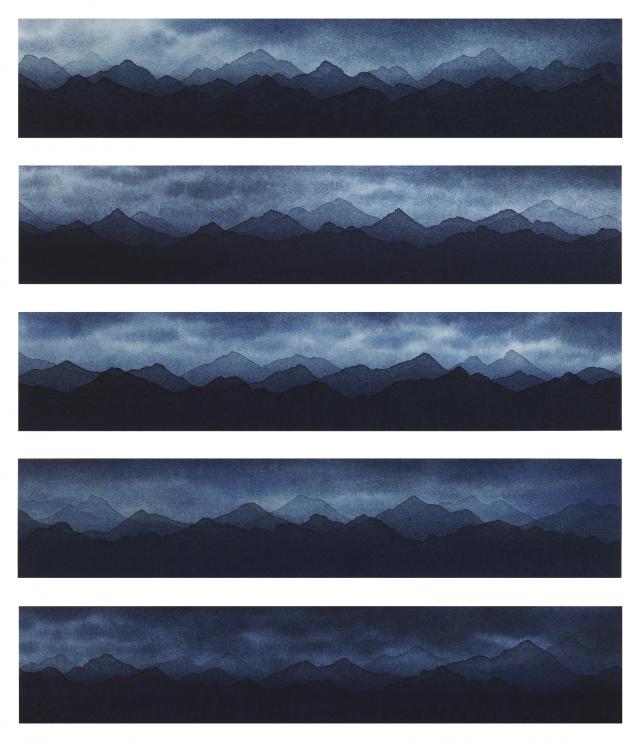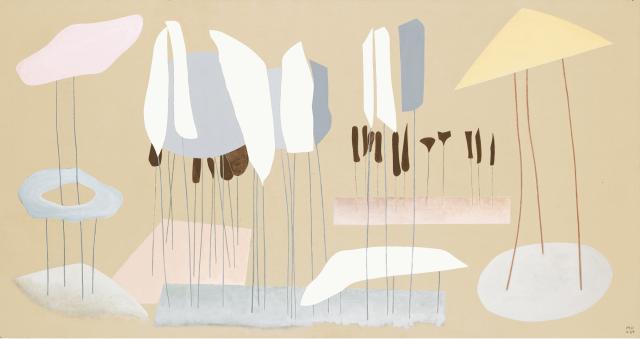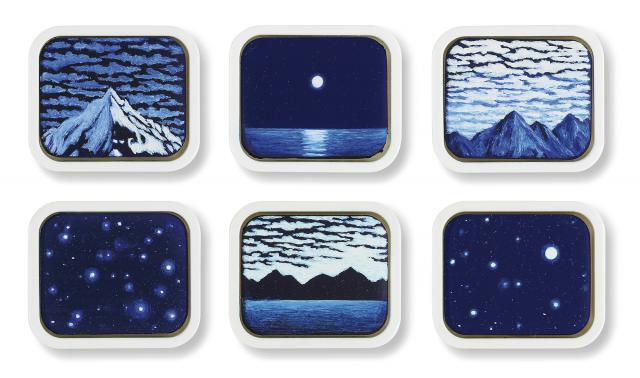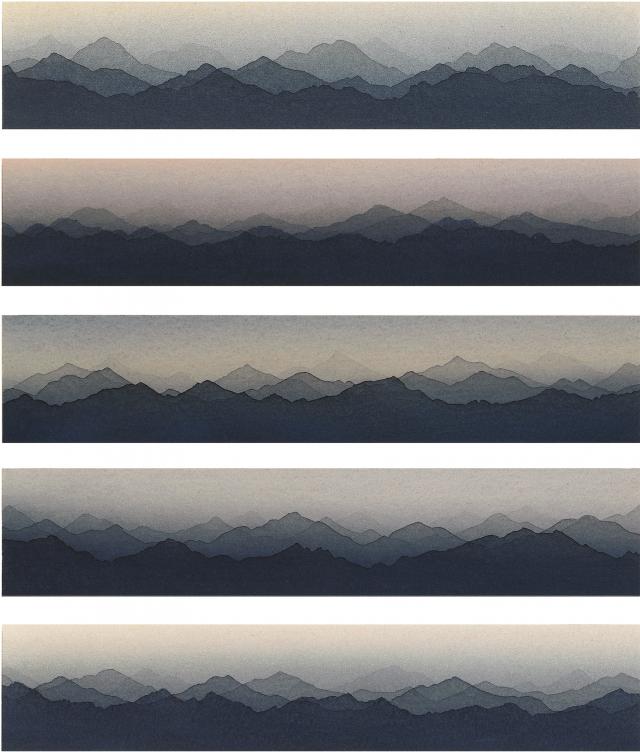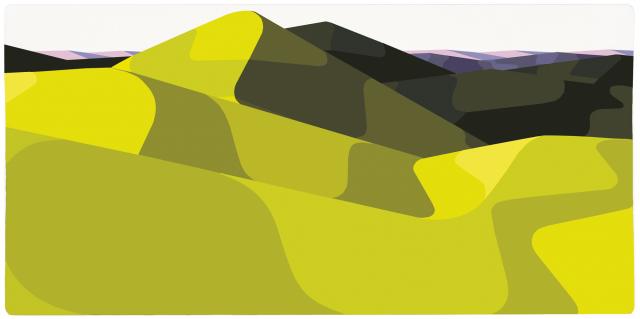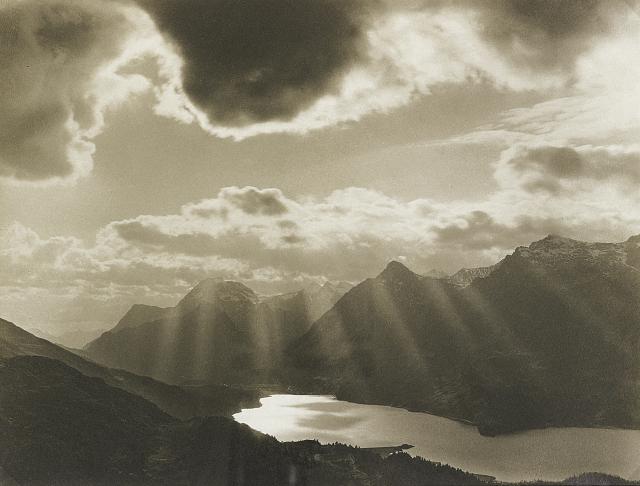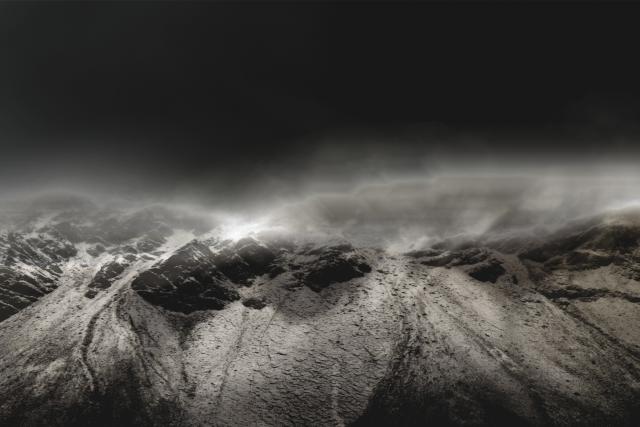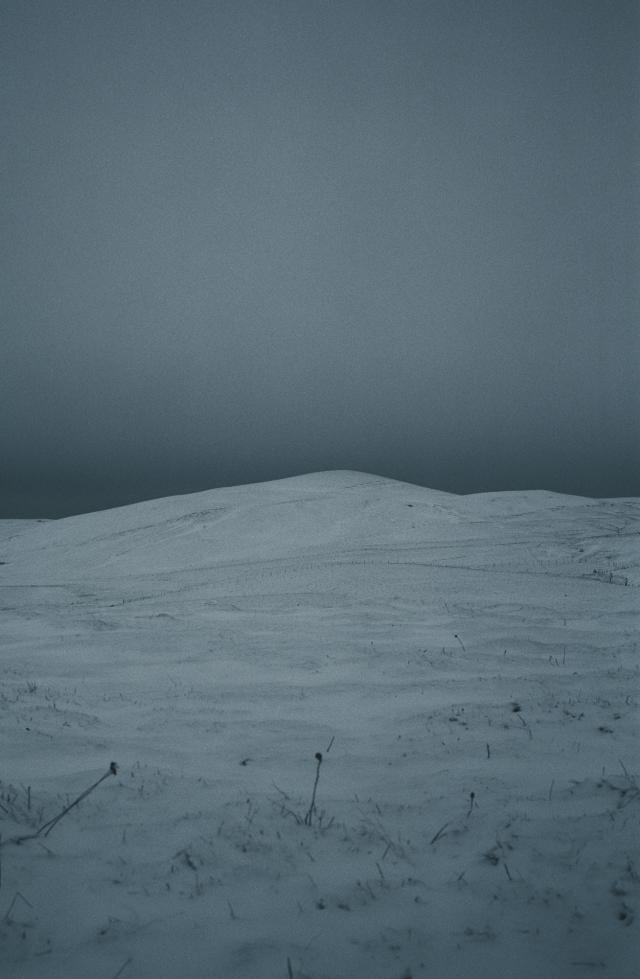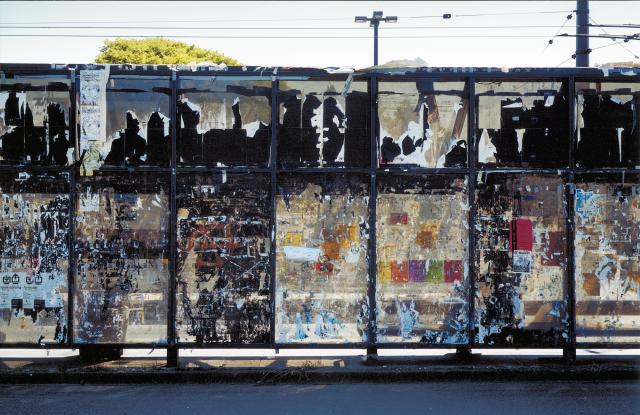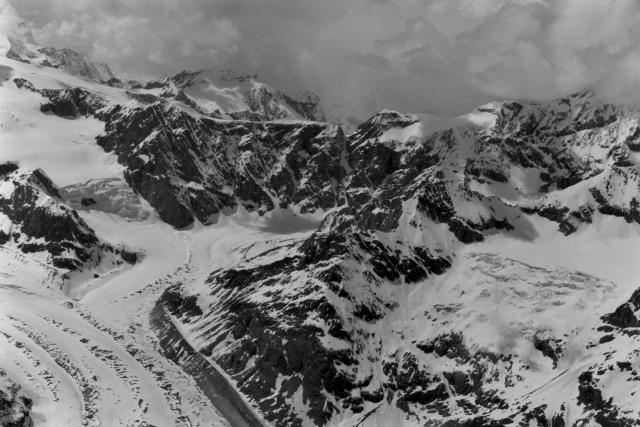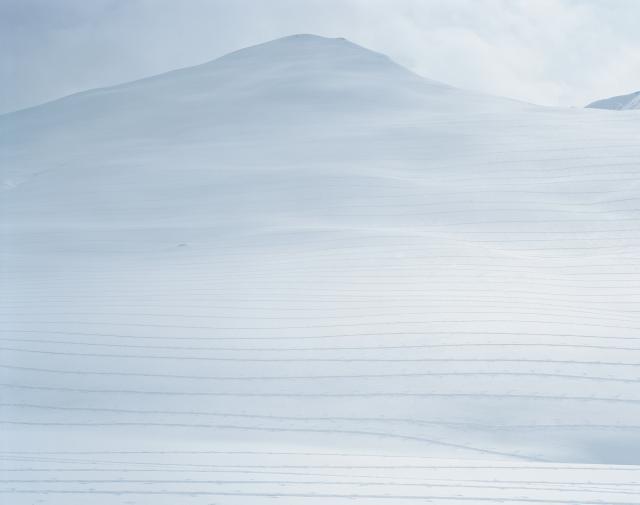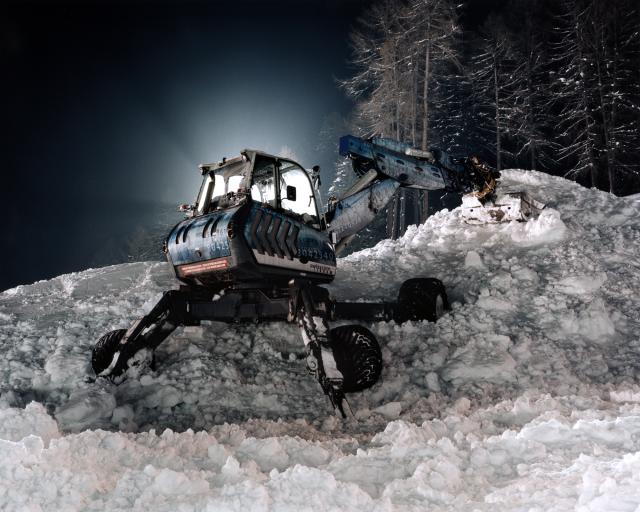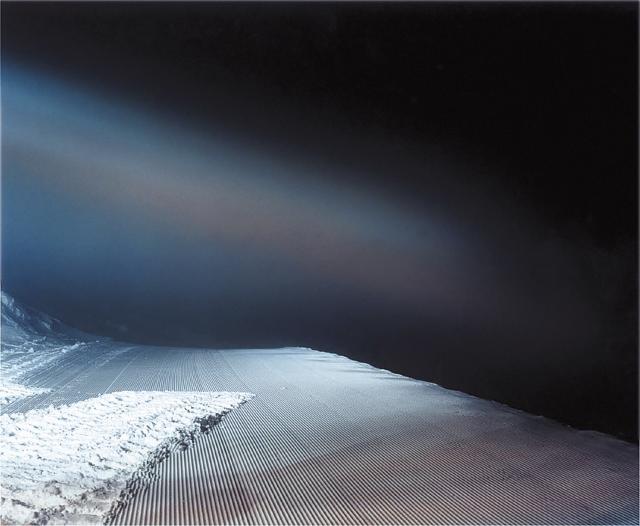In the 20th and 21st centuries
The archetypal and idyllic image of that alpine paradise continued to inspire the urban fantasies of Swiss painters well beyond the post-war period. Sometimes, the landscape was even infused with a dreamlike, magical vision in the surrealist vein, as was the case for Swiss artist Meret Oppenheim (1913-1985). Grosser Himmel mit Wolken über Kontinenten (Large Sky with Clouds above the Continents), created in 1964, reduces the elements of the alpine landscape to a formal alternation articulated through a dialectic of roundness/angularity, verticality/horizontality. Above all, Meret Oppenheim’s clouds demonstrate a physiognomic variety, from the accumulation and arrangement of forms one after another, without any perspective or any vanishing point.
The working method of Basel artist Jean-Frédéric Schnyder (1945) confronts the viewer with real frustration in terms of technique, format and authenticity. By choosing a pocket-sized format, Schnyder shunned any claim to sublime grandeur. As a consequence, when he did a pastiche of Ferdinand Hodler’s expressive style and appropriated the motif of the alpine summits, Schnyder did it in a casual and corrosive way, without any real intention to rival the masters of the genre.
Play with small formats that challenge sublime grandeur is also found in the practices of Michel Grillet (1956) and Albrecht Schnider (1958). Like the Genevan miniatures of the 18th century, Grillet brings a watchmaker’s precision to his work on the representation of mountainous landscapes, horizons and starry skies, raising questions linked to the nature of the image rather than the image of nature. Schnider reverses the traditional relationship between subject and format found in the history of classical art. Again through pocket-sized formats, he reduces representation to its essential elements to the point that the multiplication of planes and geometric patterns makes the paintings echo digital creations.
In that spirit, from the mid-20th century to the present day, the representation of the landscape has been gradually opening to mediums of expression other than painting. Albert Steiner (1877-1965) endeavoured to establish photography as an autonomous means of creation. With the help of his camera, he sought to “differently” depict the elegance of the mountain landscapes of the Engadin, with their glaciers, deep crevices and distant summits, in order to make the heavenly charm of Alpine space perceptible. Annelies Strba (1947) also attempts to reveal the hidden harmony is natural space through photography, but uses digital tools to do this. Though she often works “like a painter”, she uses Photoshop as a paintbrush. In her landscapes, this generally enables her to freeze the low-angled light that gives shape to the craters, to sharpen the relief and dramatise the shadows, although she sometimes manages to achieve a hyper-realistic effect in her shots without using digital tools, as in her series Mountains (2006), created during a stay in the canton of Grisons.
The artist duo Monica Studer (1960) and Christoph van den Berg (1962) take the exploration of new mediums even further. Since 1996, they have chosen to express themselves solely through synthetic images. The alpine landscapes presented to viewers are nothing but the result of a computer construction, organised by clever algorithms and vector calculations developed by the two artists. In the same vein as Caspar Wolf, Studer and van den Berg erase the reality of the landscape in favour of an artificial, fictional reconstruction, put together on the basis of recollections and stereotyped mental representations of the alpine world.
Consequently, if there is still a romantic, bucolic vision of the alpine motif at the turn of the 21st century, this is only possible in the context of subversive artistic approaches that focus on the technical quality of images. Le Godde by Claudio Moser (1959) primarily explores the pictorial qualities of photography. Moser’s preference for inkjet over chemical processes makes it possible to mix hues directly on the paper, by reducing the density of colours. In this way, Moser avoids spectacular light effects within that timeless landscape, emptied of all movement and all human presence. Balthasar Burkhard (1944-2010) used the technical peculiarities of silver photography when creating his shots. Without giving too much attention to the negatives, Burkhard prepared to capture his image like a film director. More than a real representation of the landscape, he sought the evocative power of the subject, endeavouring to bring a physical, almost sculptural dimension to his photographs. The landscape proved to be the tool and not the result of his aesthetic search: “I don’t photograph landscapes, but rather a subject that is there and awakens something in me, emotions, a feeling, and it matters little whether it’s a city or landscape.”
For Thomas Flechtner (1961), choosing a heavy, unwieldy camera gave him the thinking time necessary for “approaching what one is unconsciously seeking”. By using a technique that is “archaic in these modern times”, Flechtner accepts slow displacement in space, offering himself the possibility of mentally creating the image before pressing the shutter-release. The image of snow with blue reflections that invades the composition and pushes back the sky in Avers (Walks) is simply the result of that long, solitary process, the visible means offered to viewers, in order to question human presence in the natural environment and grasp the ephemeral transformation of the landscape.
At the other extreme, Jules Spinatsch (1964) explores lasting changes in the landscape. By multiplying the points of view, genres and photographic techniques used, he seeks to capture the conversion that the alpine landscape is being forced to undergo in order to meet human requirements. His projects Snow Management (2001) and Welcome to Photostudio Titlis (2008) examine the folkloric, stereotyped painting of a land with idyllic mountains, and they openly free themselves from the heavenly images of snowy Alps and sumptuous untouched nature that were celebrated in the 18th century. Spinatsch thus condemns a vulnerable contemporary environment, controlled by human beings, subject to their economic and tourism needs, to their perpetual dissatisfaction.
This break away from romantic and nostalgic representations of Switzerland is undeniable in the photographic work of Nicolas Faure (1949). His imposing alpine summits are obscured by traces of human interventions on the landscape. Motorway structures often serve as a foreground to the imposing landscapes they cross, and in other images, they can be made out in the distance, on a lunar pond, in a play of almost abstract patterns. By renouncing the search for the sublime in his representation of the natural environment, Faure reveals what is there, straightforwardly, from a desire to document the surrounding world.
This return to an objective, almost documentary perspective on the Swiss landscape could be considered an echo of the first depictions of the Alps in genre painting. However, though the overall view it provides by indexing almost four centuries of Swiss artistic practices, Collection Pictet shows viewers the subtle transformations that occurred over time, in terms of available techniques and what comes into play. Although the motif of the Alps has been tackled in different ways throughout the history of Swiss art, although the summits have been changed and redefined through paintings, engravings and photographs, landscape time keeps ticking.
